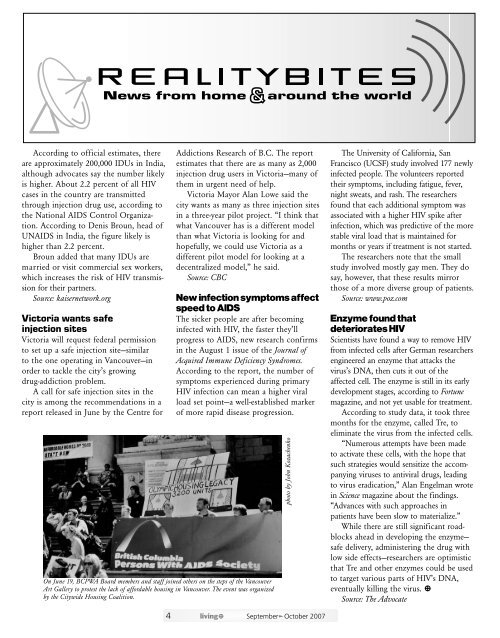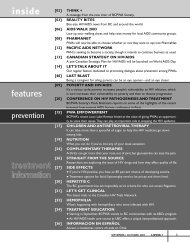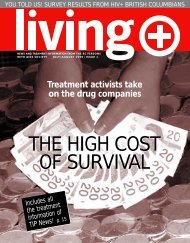iv poz mag.qxd - Positive Living BC
iv poz mag.qxd - Positive Living BC
iv poz mag.qxd - Positive Living BC
You also want an ePaper? Increase the reach of your titles
YUMPU automatically turns print PDFs into web optimized ePapers that Google loves.
issue 50.<strong>qxd</strong>:l<strong>iv</strong> <strong>poz</strong> <strong>mag</strong>.<strong>qxd</strong> 9/3/07 4:04 PM Page 4<br />
According to official estimates, there<br />
are approximately 200,000 IDUs in India,<br />
although advocates say the number likely<br />
is higher. About 2.2 percent of all HIV<br />
cases in the country are transmitted<br />
through injection drug use, according to<br />
the National AIDS Control Organization.<br />
According to Denis Broun, head of<br />
UNAIDS in India, the figure likely is<br />
higher than 2.2 percent.<br />
Broun added that many IDUs are<br />
married or visit commercial sex workers,<br />
which increases the risk of HIV transmission<br />
for their partners.<br />
Source: kaisernetwork.org<br />
Victoria wants safe<br />
injection sites<br />
Victoria will request federal permission<br />
to set up a safe injection site—similar<br />
to the one operating in Vancouver—in<br />
order to tackle the city’s growing<br />
drug-addiction problem.<br />
A call for safe injection sites in the<br />
city is among the recommendations in a<br />
report released in June by the Centre for<br />
Addictions Research of B.C. The report<br />
estimates that there are as many as 2,000<br />
injection drug users in Victoria—many of<br />
them in urgent need of help.<br />
Victoria Mayor Alan Lowe said the<br />
city wants as many as three injection sites<br />
in a three-year pilot project. “I think that<br />
what Vancouver has is a different model<br />
than what Victoria is looking for and<br />
hopefully, we could use Victoria as a<br />
different pilot model for looking at a<br />
decentralized model,” he said.<br />
Source: C<strong>BC</strong><br />
New infection symptoms affect<br />
speed to AIDS<br />
The sicker people are after becoming<br />
infected with HIV, the faster they’ll<br />
progress to AIDS, new research confirms<br />
in the August 1 issue of the Journal of<br />
Acquired Immune Deficiency Syndromes.<br />
According to the report, the number of<br />
symptoms experienced during primary<br />
HIV infection can mean a higher viral<br />
load set point—a well-established marker<br />
of more rapid disease progression.<br />
On June 19, <strong>BC</strong>PWA Board members and staff joined others on the steps of the Vancouver<br />
Art Gallery to protest the lack of affordable housing in Vancouver. The event was organized<br />
by the Citywide Housing Coalition.<br />
photo by John Kozachenko<br />
The Un<strong>iv</strong>ersity of California, San<br />
Francisco (UCSF) study involved 177 newly<br />
infected people. The volunteers reported<br />
their symptoms, including fatigue, fever,<br />
night sweats, and rash. The researchers<br />
found that each additional symptom was<br />
associated with a higher HIV spike after<br />
infection, which was predict<strong>iv</strong>e of the more<br />
stable viral load that is maintained for<br />
months or years if treatment is not started.<br />
The researchers note that the small<br />
study involved mostly gay men. They do<br />
say, however, that these results mirror<br />
those of a more d<strong>iv</strong>erse group of patients.<br />
Source: www.<strong>poz</strong>.com<br />
Enzyme found that<br />
deteriorates HIV<br />
Scientists have found a way to remove HIV<br />
from infected cells after German researchers<br />
engineered an enzyme that attacks the<br />
virus’s DNA, then cuts it out of the<br />
affected cell. The enzyme is still in its early<br />
development stages, according to Fortune<br />
<strong>mag</strong>azine, and not yet usable for treatment.<br />
According to study data, it took three<br />
months for the enzyme, called Tre, to<br />
eliminate the virus from the infected cells.<br />
“Numerous attempts have been made<br />
to act<strong>iv</strong>ate these cells, with the hope that<br />
such strategies would sensitize the accompanying<br />
viruses to ant<strong>iv</strong>iral drugs, leading<br />
to virus eradication,” Alan Engelman wrote<br />
in Science <strong>mag</strong>azine about the findings.<br />
“Advances with such approaches in<br />
patients have been slow to materialize.”<br />
While there are still significant roadblocks<br />
ahead in developing the enzyme—<br />
safe del<strong>iv</strong>ery, administering the drug with<br />
low side effects—researchers are optimistic<br />
that Tre and other enzymes could be used<br />
to target various parts of HIV’s DNA,<br />
eventually killing the virus. 5<br />
Source: The Advocate<br />
4 l<strong>iv</strong>ing5 SeptemberqOctober 2007











